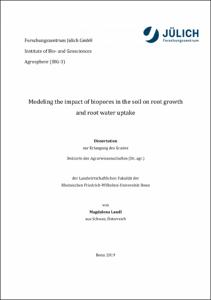Modeling the impact of biopores in the soil on root growth and root water uptake

Modeling the impact of biopores in the soil on root growth and root water uptake

| dc.contributor.advisor | Schnepf, Andrea | |
| dc.contributor.author | Landl, Magdalena | |
| dc.date.accessioned | 2020-04-26T18:49:20Z | |
| dc.date.available | 2020-04-26T18:49:20Z | |
| dc.date.issued | 19.06.2019 | |
| dc.identifier.uri | https://hdl.handle.net/20.500.11811/7996 | |
| dc.description.abstract | Background and Motivation: Biopores are tubular shaped cavities in the soil formed by biological activity that enable plant roots to reach water and nutrient reservoirs at greater depths. Especially during prolonged drought periods or when the topsoil is nutrient depleted, biopores play an important role in plant nutrition and can help to reduce the required amount of irrigation and fertilization. Direct measurements of the impact of biopores on root growth, root water and nutrient uptake are difficult. 3D root architecture models can help to systematically investigate the influence of different environmental conditions on root system development, to interpret experimental data and to test hypotheses on root– soil interaction processes on different scales. However, parameterization of such models is challenging due to the large effort of measuring root system traits. Methods: We developed a new model approach for the simulation of root system development in soil with biopores, which is based on the analogy between root growth and water flow in porous media and which determines the direction of root growth as a function of soil penetration resistance. This model approach was implemented into the mechanistic 3D model R-SWMS, which allows the simulation of root growth and water flow in the soil- root continuum. To improve the parameterization of the root growth module, we evaluated distributions of different root architecture traits from 2D root images of various wheat varieties. Using data from a field experiment, we then applied the coupled simulation model to evaluate the impact of biopores on root growth and root water uptake under realistic environmental and soil physical conditions. Results: We tested our new model approach on the single root and the root system scale using data from literature. Root trait analysis allowed us to quantify gravitropism and tortuosity parameters and showed the influence of parameter distribution on root foraging performance. Simulations under field conditions and evaluation with extensive field data confirmed that biopores mitigate transpiration deficits in times of water scarcity by allowing roots to take up water from deeper, less dry soil regions. This benefit persisted even under the assumption of reduced root water uptake in biopores due to limited root-soil contact. Conclusions: The good agreement between simulated and observed root growth patterns in structured soil confirmed the new model approach for modelling root growth in soils with biopores. 2D image analysis allowed us to systematically and efficiently analyze root system architectures and to identify model parameters. Plot-scale simulations with different scenarios of environmental and soil physical conditions provided new insights into the influence of biopores on plant transpiration. | en |
| dc.language.iso | eng | |
| dc.rights | In Copyright | |
| dc.rights.uri | http://rightsstatements.org/vocab/InC/1.0/ | |
| dc.subject | Wurzelwachstumsmodell | |
| dc.subject | Wurzelwasseraufnahme | |
| dc.subject | Makroporen | |
| dc.subject | Wurzelarchitektur | |
| dc.subject | Wurzelparametrisierung | |
| dc.subject | root growth model | |
| dc.subject | root water uptake | |
| dc.subject | macropores | |
| dc.subject | root architecture | |
| dc.subject | root parameterization | |
| dc.subject.ddc | 570 Biowissenschaften, Biologie | |
| dc.title | Modeling the impact of biopores in the soil on root growth and root water uptake | |
| dc.type | Dissertation oder Habilitation | |
| dc.publisher.name | Universitäts- und Landesbibliothek Bonn | |
| dc.publisher.location | Bonn | |
| dc.rights.accessRights | openAccess | |
| dc.identifier.urn | https://nbn-resolving.org/urn:nbn:de:hbz:5n-54943 | |
| ulbbn.pubtype | Erstveröffentlichung | |
| ulbbnediss.affiliation.name | Rheinische Friedrich-Wilhelms-Universität Bonn | |
| ulbbnediss.affiliation.location | Bonn | |
| ulbbnediss.thesis.level | Dissertation | |
| ulbbnediss.dissID | 5494 | |
| ulbbnediss.date.accepted | 29.01.2019 | |
| ulbbnediss.institute | Mathematisch-Naturwissenschaftliche Fakultät : Fachgruppe Biologie / Institut für Genetik | |
| ulbbnediss.fakultaet | Landwirtschaftliche Fakultät | |
| dc.contributor.coReferee | Vanderborght, Jan |
Dateien zu dieser Ressource
Das Dokument erscheint in:
-
E-Dissertationen (1116)




